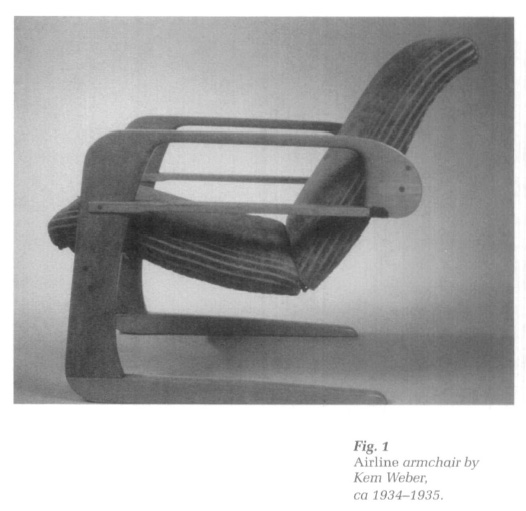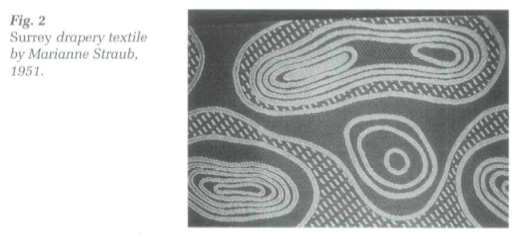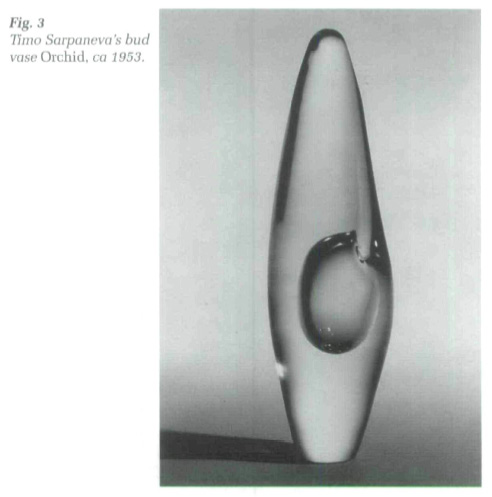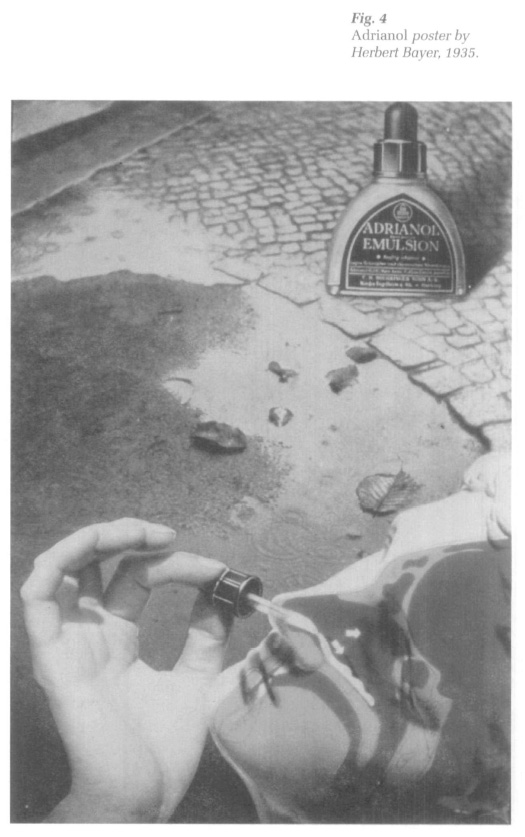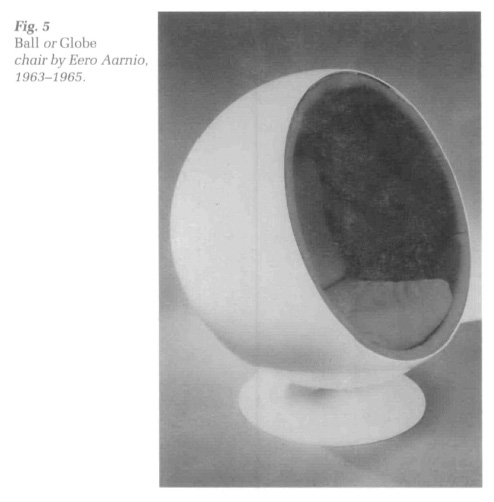Reviews / Comptes rendus
Canadian Museum of Civilization, Design 1935-1965: What Modern Was
Curators: Luc d'lberville-Moreau, Musée des arts décoratifs de Montréal in collaboration with David A. Hanks & Associates, New York, and Martin Eidelberg
Designers: Michael Lerch Co. of Montreal and Pamela Morse
Duration: 3 February to 24 May 1993
Production: This exhibition was organized by Le Château Drufresne, Musée des arts décoratifs de Montréal, with a grant from the IBM Corporation.
Publication: Catalogue, 424 pp., edited by Martin Eidelberg
1 The introductory caption for the exhibition Design 1935-1965: What Modern Was notes that "Advocates of Modernism saw it as the embodiment of the twentieth-century ideal of a democratic society." The caption does not explain how modernists intended to bring this about. However, one practitioner, Frank Lloyd Wright, whose work is represented in this show, was specific in his 1901 Hull House Lecture: "The machine is here to stay. It is the forerunner of the democracy that is our dearest hope." The exhibition What Modern Was, at the Canadian Museum of Civilization in Hull from 3 February to 24 May 1993, presents us with a series of eight distinct theme-related exhibit spaces filled with over 250 artifacts, most of whose aesthetic underpinnings were determined in either a positive or negative relation to the machine.
2 What Modern was, then, in the sphere of design, was a response, formulated as early as the last half of the nineteenth century by the Arts and Crafts movement in England, to the intrusion of the machine into the world of the craftsman. This exhibition, originating from the Musée des arts décoratifs de Montréal (whose mandate is to create "a new collection of international distinction," by implication, a collection of "masterpieces"), could better be titled "Defining the Modern: 1935-1965." We are given examples of the works of some of the most internationally renowned designers of this century, the men and women who defined the rules for Modernism, though only in its later phases. Without question, the influence of these designers was widespread and, further, many of the articles in the show did have a wide distribution. However, the work of the many anonymous individuals working within design departments who disseminated Modernism, thereby fulfilling the democratic/machine ideal, is underrepresented. If Modernism began to be formulated in the nineteenth century, the visitor needs to see some reference to this. If Modernism was the aesthetic of the machine age, then we need to see a much broader selection of industrial design. Apart from Henry Dreyfuss' "Thermos" in the Streamlined Modern section, the viewer is given only one really striking example, the "Avanti" car, which is displayed in the entrance lobby of the Museum, seemingly out of place. What Modern actually was should be much more than what is shown here. The intellectual framework of this exhibition needs some rethinking. Having said this, however, it must be noted that its contents are, indeed, quite magnificent.
3 The show space is divided into a sequence of galleries, each with its own distinct personality. The very effective design work is by Michael Lerch Co. with Pamela Morse, and the equally appropriate lighting is by Blomeley Communications. The first gallery, The Modernist Canon, is a large, bright, undivided space that has arranged around its neutrally coloured walls examples of furniture, fabrics, ceramics and commercial art, which give us an excellent overview of the Modernism of this period at its most basic. The fluid shapes and warm wood texture of the furniture, as well as its arrangement in small configurations on multicoloured platforms against lengths of fabric suspended from the walls, creates a mood of comfort and familiarity. Even the metal and rubber chairs of Donald Knorr, Hans Coray and Davis Pratt are "tamed" by the fabrics of Ed Rossbach, Ray Eames and Angelo Testa, which hang behind them.
4 The following gallery, devoted to Streamlined Modern, is much smaller, but nonetheless has considerable drama, particularly because, as we enter, we see the "Airline" armchair of Kem Weber (Fig. 1). It is set against a black curtain and appropriately mounted on a brushed metal platform that suggests the aerodynamic shape of an airplane wing. Against the next wall stands the three-and-a-half-foot-high, multicoloured "Penny Phono" jukebox, which is the most assertive statement of this design mode because of its size and ornamental horizontal lines. Several small objects displayed in cases all share elements of the rounded form or swept lines that originated in one phase of the Modern or Art Deco movement as it moved away from the zig-zag patterns of the 1920s into the speeding lines of the 1930s. A caption in this gallery notes that this phase of Modernism had "a wide audience" and was "a popular style," but we are not shown why, even through posters or advertising of, for example, the appliances that retained this shape into the 1950s. The catalogue does fill this gap somewhat. In Martin Eidelberg's essay a handful of "applied art" objects are mentioned including Raymond Loewy's pencil sharpener.
5 Another small gallery presents us with selections of Biomorphic Modern. Here we are given cases of small items such as the convoluted jewelry of Margaret de Patta and Henning Koppel, ceramics by Eva Zeisel and glassware by Timo Sarpaneva. Typical of the curvaceous lines of this mode is the textile "Surrey" by Marianne Straub (Fig. 2). A dramatic display of furniture by Isamu Noguchi, Carlo Mollino and Eva Zeisel dominates one corner of the room. The Mollino "Arabesco" table is particularly interesting and foreshadows some of the complexity seen in the Expressionist Modern section further along in the show. As in the previous section, the caption underscores the popularity of this mode, especially in the 1950s. However, we must turn to the catalogue for the detailed evidence of this.
6 The examples of Modern Historicism are presented in a long narrow gallery and include two of the interior groupings of furniture that are a repeated motif in the layout of the show. The most striking one consists of four wooden chairs: the "Y-Chair" of Hans Wegner; the "Armchair" by George Nelson Associates; the "Riemerschmid Armchair" by Edward J. Wormley; and, finally, Gio Ponti's "Superleggera" chair. These are backed by a six-foot panel of Coral Stephens' "Swazi" textile. This section, punctuated by several cases of ceramics, glass and jewelry, illustrates the way modern designers have borrowed from the past and, particularly, the East. An extremely appealing red-and-white fabric panel, "Masks," by Ray Komai ends this gallery. It recalls primitivism, but it has a tone that is eminently urban in its suggestion of "the organization man" of the mid-century.
7 The Postwar Modernism gallery is the largest space in the show. Three captions introduce the work, detail the use of contrasting lines and explain technological changes that made possible the new directions illustrated by the artifacts. The highlights of the first furniture grouping here are the "Hanging Light Fixtures" by Massimo Vignelli. Made of multicoloured glass and almost two feet long, the lamps greatly enliven the pieces surrounding them. Further on are Arne Jacobsen's "Ant" side chair and blue "Swan" chair, both examples of the use of curved lines to soften the geometry of earlier Modernism. Another example of this is Timo Sarpaneva's technical tour de force, the bud vase "Orchid," as shown in Figure 3. Of particular interest are three drawings of interiors by Eszter Haraszty that illustrate die total "look" of a Modernist room and include images of Eero Saarinen's "Womb" chair, an example of which is on a platform nearby. The last configuration includes Harry Bertoia's red "Diamond" armchair, Eero Saarinen's blue "Pedestal" armchair, accompanied by a poster advertisement for it. and Charles and Ray Eames' "Armchair: Model DAR" in yellow. The mood of this corner is less warm than that of the other room settings because of the prominent use of metal and plastic in the chair frames. The increasing use of stronger forms of plastic points to the ubiquitousness of this media in the 1960s, as shown in the Beyond Modern gallery at the end of the show.
8 In his essay of 1908, "Ornament and Crime," Austrian architect Adolf Loos wrote, "The evolution of civilization is measured by the removal of ornament from objects of use." Happily, this exhibition's curators did not concur, and, as a result, we have the most delightful gallery in the show, the one that presents Modern Pattern and Ornament. As we enter the space, we come upon two full-length, red panels, which are part of a series of similar walls enclosing a central pillar. These add considerable drama to the displays. This section includes work in several media and among the examples of fabrics hung on the red and other panels are Alvin Lustig's "Incantation," Ruth Adler Schnee's "Seedy Weeds," and Lucienne Day's "Calyx" and "Spectators," all showing semi-abstract patterns and the influence of fine artists Klee and Mirô. Examples of advertising art include Paul Rand's poster "Subway Posters Score" and Herbert Bayer's surrealistic "Adrianol" advertisement (Fig. 4).
9 Design work by several fine artists is included in this gallery. Salvador Dali gives us six semi-abstract tiles, the eerie "Leaf Hands" fabric and the "Persistence of Memory" brooch. Fernand Léger and Alexander Calder both contribute fabrics to this gallery and the two works of Picasso shown here are his "Plate" with the dove motif and the extremely large, clown-like "Vase." On the whole, this gallery balances very successfully the earlier galleries that illustrated the original negative attitudes of many modern designers to the use of ornament, and it makes an important contribution to our understanding of Modernism.
10 As we move toward the end of the exhibition, we pass through an extremely startling gallery that presents works of Expressionist Modern. This space is small, but because two of the walls are glass, it appears quite large and very well lit. Artifacts, which include jewelry, pottery and glass, as well as furniture and tapestries, all celebrate to some extent the irrational side of creativity, in opposition to the more rational Bauhaus ideal of "functionalism," and all emphasize process. It is interesting that it was the process, mechanization, that prompted the original proto-modernist responses in the nineteenth century that eventually gave rise to the Bauhaus. Here "process" has come full circle to a strident assertion of the role of man in opposition to the machine.
11 One of the most emphatic pieces in the Expressionist Modern gallery is Magdalena Abakanowicz's black tapestry "Abakan biz." Its size, colour and obvious genital reference suggest that the role of the subconscious is the primary theme here and that the use of the visual pun is one means of expressing such preoccupation. The two wooden pieces by Wendell Castle, the "Scribe's Stool" and, in particular, the seven-foot-high, worm-like "Serpentine" floor lamp, are sculptural repetitions of Abakanowicz's assertive stance. Next to "Serpentine" is another, utterly irrational piece, Gunnar Andersen's urethane foam "Armchair." This is followed by the equally erratic "Banisteriopsis" textile sculpture by Sheila Hicks. From a 1990s perspective, it is impossible to view the last mentioned pieces without concluding that they are pushing the boundaries of design to the point of self-parody. They, even more than the work to come in the Beyond Modern gallery, suggest that the advent of Post-Modernism, with its ironic editorializing on the Modern, was inevitable.
12 The link with the Post-Modern is a deliberate theme in the last gallery, Beyond Modern. Yet, in other ways, particularly in the extensive use of plastic, the works here appear to be the apotheosis of the machine/mass-production ethos. This perspective, while lost by many of the designers and artists presented in this show, was, indeed, captured by some of the works presented.
13 Central to this Beyond Modern space is a grouping of furniture dominated by plastic and the circle. In the centre of the room, on an intersecting series of round black platforms are placed Eero Aarnio's orange-and-white plastic "Ball" or "Globe" chair (Fig. 5) and round "Kantarelli" table, Verner Panton's green, fluid "Side Chair," Vico Magistretti's small globular "Eclipse" table lamps and three stacking "Side Chairs" in red-and-white plastic by Joe Colombo. Drawing the whole module together under its huge arcing metal stem is Achille and Pier Giacomo Castiglionis' floor lamp "Arco." These pieces emphasize the off-beat, spontaneous, casualness that was the central faith of the "swinging sixties" lifestyle. Two more works in glass, Kaj Franck's large "Plaque" and Gunnar Cyrén's "Pop" goblet, celebrate the vibrating colour schemes that were meant to induce physical sensations in the eyes - a natural equivalent to the drug-induced hallucinatory quests for which the period was infamous. Finally, of particular interest are three early glass "Vases" and a "Cabinet" by Ettore Sottsass, who in 1980 founded Memphis, the design firm that played a major role in denning and promoting Post-Modernism.
14 The exhibition catalogue is edited by Martin Eidelberg, assisted by a team of 15 other contributors who wrote the notes for individual artifacts. Eidelberg's first editorial piece is an essay, "Modern in the Past Tense," in which he addresses the irony of viewing Modernism as an aesthetic whose time has passed and introduces the Stewart Collection, as well as the exhibition itself. Here and in his introduction to The Modernist Canon, he discusses the choice of 1935-65 as the time frame for the show. In the process of justifying that choice, he, of necessity, raises some embarrassing questions about the existence of Modernism, though perhaps different forms of it, in the 1920s and early 1930s - years that are excluded from this exhibition. Generally, his essays for each of the thematic sections discuss the intellectual underpinnings and technologies that created the artifacts in the show. Comments on industrial design and architecture are made, thus raising issues that are neglected in the show itself.
15 Further, there are problems with the introductory essay "The Age of the Giant State," by Paul Johnson. This discussion of public architecture and industrial design does seem out of place in a show that does not systematically stress either. What is more objectionable is his thesis that "totalitarian international" was the leading aesthetic of the period covered by the exhibition. To substantiate this, he surveys the artistic landscape of three totalitarian regimes and several administrations in which the state was expanding in the mid-century. Johnson emphasizes such examples of "modernistic" icons as electric power stations in his essay and skirts the obvious diversity in the outlooks of the wide spectrum of polities he discusses. Thus, he is able to avoid examining in depth different states' specific attitudes to Modern design of the sort presented in this show.
16 It is true that in Italy, as early as 1910-12, Mussolini began adopting some of the intellectual ammunition of Futurist poet F. T. Marinetti. The artist, who remained loyal to Fascism into the 1940s, was dismissed by Mussolini in the 1920s when neo-classicism became the official art form of the state, in spite of some tolerance of more radical architectural leanings. This ambiguous relationship between Modernism and totalitarianism was not replicated in Hitler's Germany. Elaine S. Hochman's fini; study of Mies van der Rohe's life under Hitler, Architects of Fortune, details the struggle of this architect to save Modernism from oblivion by making it acceptable to the Nazis. The suppression of such artists as Kathe Kollwitz and the closing of the Bauhaus in 1933 are just the fine brush strokes on the canvas of Hitler's wax on Modernism. The emigration of many great artists and designers is drastically underplayed in Johnson's essay even though a lengthy list of names is given in Eidelberg's essay on The Modernist Canon.
17 In the USSR, by the early 1930s the flowering Modernism of the immediate post-revolutionary years was aggressively suppressed, after years of insecurity. By 1934, Socialist Realism, the Party line, was in place. Many Modernists were persecuted. The Constructivist Vladimir Tatlin turned to stage work while El Lissitzky emigrated in 1922. Suprematist Kasimir Malevich died of cancer in 1935 after being arrested and imprisoned. By contrast, in postwar England "statism" was almost immediately manifested in the formation of the Arts Council, which sponsored art that "was intended to show the world that in the so-called 'Free World' artists produce works of great beauty and imaginative strength, whereas the Soviet 'Socialist Realist' system produces only hollow, rhetorical, academic art officiel."
18 Thus, in these "Giant States," as Johnson calls them, there was no cross-border consensus at all about the kind of art that should be produced, and in at least two of the most totalitarian regimes, the USSR and Nazi Germany, the attack on Modernism was as severe as it was successful. Does it seem appropriate, then, to coin the term "totalitarian international" in the face of this kind of evidence and to imply in some vague way that it nourished Modernism?
19 This exhibition suffers from the lack of an introductory essay in the catalogue that addresses convincingly the key issue of the relationship between democracy (in both its economic and political manifestations) and Modern design of the kind shown here. However, this issue is not entirely neglected in the essays preceding each thematic section and in the notes that accompany each artifact. In part, the notes simply give details about the objects and discuss their artistic provenance and social context. Often photographs of other works by each designer or other relevant images are included to enhance our understanding of the work being considered. Of great interest is the plethora of information given about the success or failure of many of the pieces to achieve either mass production (usually for technical reasons) or to make significant inroads into the mass market, thus fulfilling the democratic goal of Modernism. The notes give many examples, such as the "Ant" chair or the "Womb" chair, which were both successes in the marketplace. However, the comment of one contributor, Christopher Wilk, on this issue is revealing:
An introductory essay that addressed this kind of assertion specifically would have revealed whether or not this is the stance of the curators of this show, and, further, if this is a significant attitude behind the collecting mandate of the Musée des arts décoratifs de Montréal.
20 The notes also reveal that there was certainly no consensus among Modern designers about the desirability of mass production for their work. Marianne Strengell, a designer of fabrics, whose student Robert Sailors contributed to the show, "advocated that her students be able to translate the artistic quality of the handmade textile into production for the mass market." On the other hand, Eva Zeisel, particularly in her dinnerware designs "Museum" and "Tomorrow's Classic," was relatively indifferent to the market, the latter service being designed without even a commission. And her fabric and tubular steel chair of 1948-49 was never manufactured. In his essay for the Postwar Modernism section, Eidelberg summarizes the situation succinctly: "Despite the democratization of industrial design and many designers' professed goal of such democratization, there was a fair amount of self-indulgence in the design world, and many of the objects presented here were relatively costly and deluxe." Thus, the issue raised at the beginning of the show, in the captions, is a motif that runs through the entire catalogue. However, without the book, the visitor is left with this crucial issue unresolved.
21 Taken as a whole, the exhibition does make an important contribution to our understanding of the work of those who, in part, determined the "why" and "what" of Modern design from 1935-65. A general introduction in the catalogue more suitable than that written by Paul Johnson, and greater thematic consistency in the captions, would have given the visitor a clearer understanding of the significance of these artifacts in their social context. A complete picture of what Modern really was, then, would require more and different perspectives on this cultural current that has been so central to the twentieth century.
